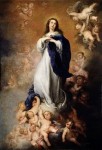Does Immaculate Conception Mean Virgin Birth?
Does Immaculate Conception mean Virgin Birth?
No. These two concepts, Immaculate Conception and Virgin Birth, are frequently confused. Many assume they are one and the same, leading to the notion that Mary’s conception was the result of the same type of divine intervention as that of her son. In fact, the Church has never believed that Mary was conceived without marital relations occurring between her parents. Normal physical relations between a husband and wife are not seen as sinful. They are, in fact, seen as a source of divine grace, a sharing in God’s life of love, a sacramental experience.
What is the Immaculate Conception?
If Immaculate Conception has nothing to do with the notion that our sexual expression is evil, however necessary for the continuation of the species, nor is it some kind of impediment to holiness, then what does the concept mean? To understand the notion, we must start with an ancient story, one of two creation myths found in the Bible: the story of Adam and Eve in the Garden of Eden. This second story of creation begins in the second chapter of the book of Genesis, halfway through the fourth verse. It tells of the creation of a human and then of a garden in Eden in which he would live. The garden was located in the land bordered by four rivers: the Pishon, the Gihon, the Tigris, and the Euphrates. In this garden, there was a tree, the tree of the knowledge of good and evil, from which the man was forbidden to eat the fruit. Knowing the man would be lonesome alone in the garden, God created many animals and birds to accompany him. However, animals and birds were not suitable companions for a human on any long-term scale. So God created another human to be his partner; a human created from the man’s rib to signify equality with him. The man was named Adam (man), a play on words in Hebrew between “man” and “ground.” The new person was called woman because she was formed out of “her man.”
As the story continues, conflict enters. The woman, walking alone in the garden, encounters a serpent who cunningly entices her to taste the forbidden fruit. She gives some to her husband as well, and suddenly they recognize they are naked. They become afraid to see God and hide in the garden from their creator. A separation between God’s overflowing love in creation and the humans created to be part of that creation has occurred. According to the story, the man and woman must leave the garden and now make their way in the great world outside it. The woman was called Eve by her husband “because she became the mother of all the living.”
Enter Original Sin
From this story, told to explain the entry of sin into human experience, the notion of original sin eventually developed. According to this notion, not found in Judaism or Islam, all humans inherit a “fallen nature,” a nature that is not strong enough always to resist sinning (separating from God). We don’t inherit the guilt of Adam and Eve. God’s image is undiminished within us, always calling and helping us to choose life over death. Yet we all fail in the quest to live without sinning through our decisions to act or to fail to act in loving union with God.
How then could God’s Son be born of a human woman without inheriting that fallen nature? It was from this dilemma that the notion of the Immaculate Conception developed. Through the centuries, theologians wrestled with it, especially as the idea of original sin became more and more strongly developed. Originally Mary was seen as like all other humans, a normal woman who played an extraordinary role in salvation history through her total openness to God. By the Middle Ages, however, as we began to focus more on human sinfulness and less on the presence of God within each person, an idea developed that Mary was saved from original sin at the time of her conception to prepare a perfect “new Eve” from whom the long-promised savior would be born. This savior would be the first-born of God’s new creation, of God’s new people.
A Formal Dogma
It wasn’t until the middle of the 19th century that the Immaculate Conception became a formal dogma of the Roman Catholic Church. This feast is celebrated nine months before we celebrate the Nativity of Mary (September 8). The readings for the liturgy celebrating the Immaculate Conception include the story of the encounter between God, the serpent, and Adam and Eve in the Garden of Eden (Gen 3:9-15), Paul’s letter to the Ephesians describing God’s choice to adopt all of us through Jesus (Eph 1:3-6, 11-12), and the story of the visit of the Angel Gabriel to Mary in which Mary gives her consent to become Jesus’ mother (Lk 1:26-38). Perhaps the confusion between the Immaculate Conception and the Virgin Birth stems from this traditional selection of readings. They are connected only to the extent that God’s grace is needed by all humans to help them make loving choices and help bring the new creation to birth right here, right now!










